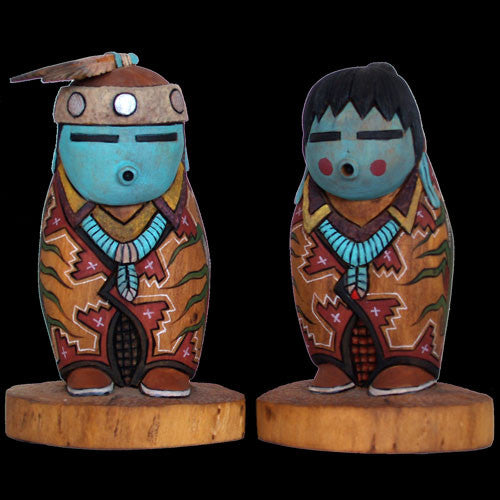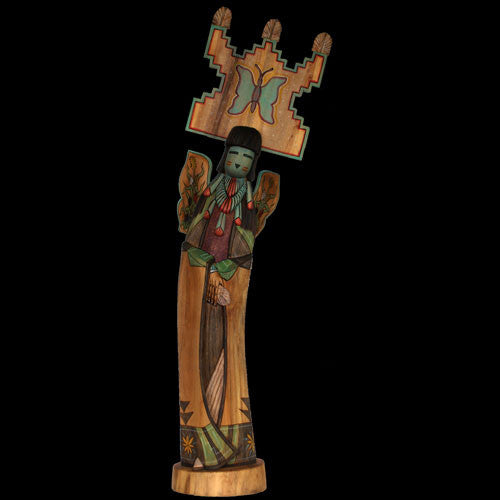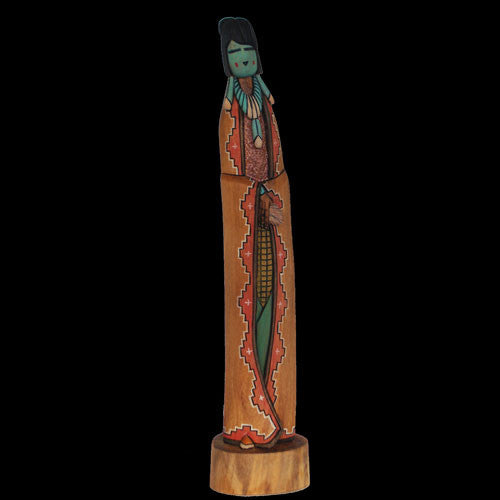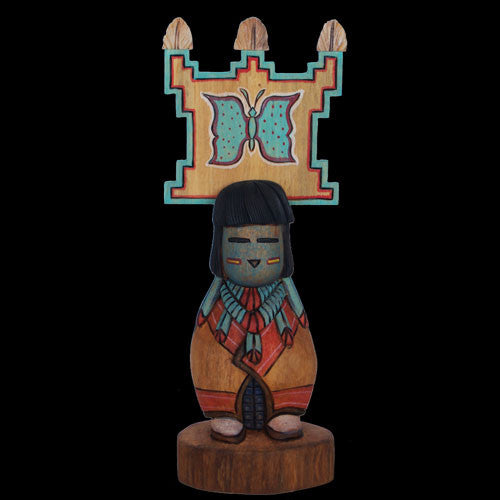Product Categories
SHOP BY ARTIST
NEWSLETTER
Dennis Ross

Navajo 2 Piece Creation/Corn Set - Dennis Ross (#58)
$495.00
Artist: Dennis Ross
Folk Art
Largest base: 3 3/4"
Tallest figure: 6 1/2"
Dennis Ross creates people; short, chubby people with a story to tell. In this case, it is a corn family of 2 with husband and wife. These individuals inform us that the first Navajo people were created from corn and that corn remains an important aspect of Navajo life, as a food source, as a cultural staple and as a fertility symbol. Dennis is not afraid to put a lot of detail into his sculptures, and that is apparent from these carvings. Take them home, you will love them forever.
We offer a 100% satisfaction guarantee on every purchase.
About the artist:

Asked how he first started carving, Dennis Ross answers with a laugh, "My brother - he gave me a knife, and a stone, and a piece of carving wood, and said, 'Here you go'." Dennis was twenty-six years old. His brother, Harry Bert, also gave him a little constructive criticism on that first experiment into the creative world of carving, but Dennis took it from there.
Related legends:
Corn in Navajo Traditional Life
The Supernaturals also warn him of taboos connected with the use of corn. It should not be cooked until it is ripe nor eaten before it is fully cooked, or frost and floods will damage the crop. In the "vigil of the corn" ceremony the corn is fed with dried meat; if it were to be fed with corn it would thus consume itself, just as feeding meat to the masks would cause men to eat each other. When giving this warning Talking God refers to the time that ugly woman fed corn to the corn with result that " the people starved and men ate the flesh of other men."?
Dine Emergence/Creation
This is a story told by the Navajo people by word of mouth to the young and old. The Navajo believe there are Five Worlds. We are presently in the fifth world. The first world was a small, dark and water filled world. It was known as the Red World where the flying insects were the first and only people. The second world was blue with the air. The spirit people here were swallows? More about this legend

Navajo Butterfly Corn Maiden Cottonwood Carving - Dennis Ross (#70)
$1,100.00
Artist: Dennis Ross
Folk Art
Base: 6" x 4 3/4"
Height: 31"
Dennis Ross inhabits many cultures all at the same time, and his carvings speak not only of interesting art, but also of legends, history and ancient stories. He is half Hopi and Navajo and his art showcases that side of him. In this piece Dennis has taken a branch of dried out cottonwood root, than whittled, sanded, painted, and made a beautiful butterfly sculpture. Adding imagery of corn, fertility, prayer and turquoise; Dennis has done what he always does best; carving things of beauty out of wood.
We offer a 100% satisfaction guarantee on every purchase.
About the artist:

Asked how he first started carving, Dennis Ross answers with a laugh, "My brother - he gave me a knife, and a stone, and a piece of carving wood, and said, 'Here you go'." Dennis was twenty-six years old. His brother, Harry Bert, also gave him a little constructive criticism on that first experiment into the creative world of carving, but Dennis took it from there.
Related legends:
Butterfly in Navajo Traditional Stories
Butterfly: Due to the natural beauty of its wings, Butterfly is often considered vain. Yet, in Navajo mythology, Butterfly brings the sacred flint to the hooves of the horse. In the legend of the diety, Butterfly Boy was cured of his vanity by being lightning struck with the axe of Rain Boy. After that, his head opened up and out of it came the butterflies of the world. The perishable dust of Butterfly's wings is sometimes thought to prove that such beauty is usually not durable.

Navajo Corn Maiden Handmade Carving - Dennis Ross (#72)
$375.00
Artist: Dennis Ross
Height: 17" Base: 3 1/2" x 3 1/4"
Slender elegance, that is what Navajo-Hopi carver Dennis Ross has captured in this cottonwood rood carving. The elbows and bends on the San Juan River here in Bluff are where he gets his specimens. Than with his burly hands, delicately carves and paints his way around them to bring them to life. Using yellow corn, which also represents west, indicates abundance and productivity. He has once again captured the essence of this meaningful symbol.
About the artist:

Asked how he first started carving, Dennis Ross answers with a laugh, "My brother - he gave me a knife, and a stone, and a piece of carving wood, and said, 'Here you go'." Dennis was twenty-six years old. His brother, Harry Bert, also gave him a little constructive criticism on that first experiment into the creative world of carving, but Dennis took it from there.
Related legends:
Corn Spirits in Navajo Mythology
Then it was that they moved upward, leaving the dark world behind. They climbed on top of the Four Mountains, which grew upward with them, and they all moved up onto a lighter world. The Wind People brought seeds into the new world, and they planted them:?

Navajo/Hopi Blue Corn Butterfly Maiden Carving - Dennis Ross (#73)
$315.00
Artist: Dennis Ross
3 3/4" x 3" Height: 10 1/2"
Dennis Ross, Navajo/Hopi artist, has the hands of a lumberjack and the carving ability of a sculptor. Because of his dual heritage Dennis often blends design and motif to craft his imaginative art forms. In this case Dennis has produced a sculpture that portrays a Hopi Butterfly Maiden that is believed to govern the spring and a Navajo Corn Spirit that allows growth of the most precious of food source. The combination of characters allows for a most attractive and appealing figure.
About the artist:
 Asked how he first started carving, Dennis Ross answers with a laugh, "My brother - he gave me a knife, and a stone, and a piece of carving wood, and said, 'Here you go'." Dennis was twenty-six years old. His brother, Harry Bert, also gave him a little constructive criticism on that first experiment into the creative world of carving, but Dennis took it from there.
Asked how he first started carving, Dennis Ross answers with a laugh, "My brother - he gave me a knife, and a stone, and a piece of carving wood, and said, 'Here you go'." Dennis was twenty-six years old. His brother, Harry Bert, also gave him a little constructive criticism on that first experiment into the creative world of carving, but Dennis took it from there.
Related legends:
Corn Spirits in Navajo Mythology
Then it was that they moved upward, leaving the dark world behind. They climbed on top of the Four Mountains, which grew upward with them, and they all moved up onto a lighter world. The Wind People brought seeds into the new world, and they planted them:?
